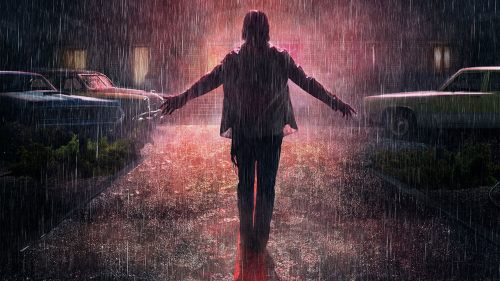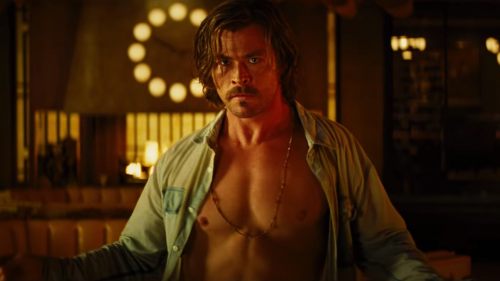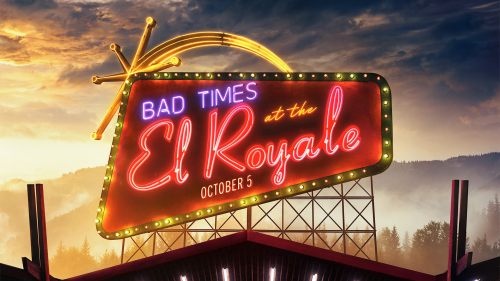The Sublime Efficiency of Drew Goddard’s CLOVERFIELD Script
Bad Times at the El Royale hits theaters soon. Get your tickets here!
In a vacuum—devoid of hype or teaser trailers or augmented reality games—Drew Goddard’s screenplay for Cloverfield begins so inauspiciously that one might be confused as to what sort of film the writer is intending to make. The only hints that something extraordinary is about to unfold are the staccato title cards that open the script, explaining that this is footage found at “Incident Site US-447 (formerly known as Central Park).”
“WIDE ON THE CITY – We’re looking down on Manhattan as the morning sun breaks through the skyline,” is the first action beat we read. The man we assume is our protagonist, Rob Hawkins, tells us what time it is (“Six forty-two a.m.”) and that it is already “a good day.” He’s deep into the kind of idyllic morning only couples in movies can ever actually have. Never do we see him brush his teeth or use the restroom. He is too busy fawning over Beth, described as “nearly angelic” (the underlining is all Mr. Goddard’s).
Movies usually end like this, the good guy gets his perfect girl and they greet the new day with post-coital bliss. No film starts this happily, unless all of that joy is about to be ripped away in the most grotesque, horrific fashion possible. Of course, that is exactly what happens in Cloverfield, Goddard’s first produced feature script. Lost in the hype of the film’s 2008 release, the revolutionary found-footage look executed by director Matt Reeves, and the furthering of JJ Abrams’s multi-platform empire is just how effective Goddard’s script really is. Disaster movie clichés are bent, twisted, and reformed into something that feels fresh and modern, even today. Just like his latest, the “quirky characters trapped in a hotel” film Bad Times at the El Royale, the scope is small, the characters are well-defined archetypes, and obfuscation is paramount.
As movies become more and more obsessed with satisfying some sort of informal spectacle quota, Cloverfield embraces its limitations and, for better or worse, exploits our very real fears—two of the hallmarks of effective horror. And as much as this is a paean to Godzilla and the lineage of the giant monster movie, it is very much an extended exercise in horror filmmaking. Horror protagonists are often happy, usually naïve, and always unprepared for what they’re about to face. We see Rob and Beth in their state of bliss, before the videotape we’re meant to be watching fast-forwards to the night in question—Rob’s going away party. He’s off to take a new job in Japan and Beth has a new beau that she brazenly brings to the party, setting Rob off.
It would be easy for Goddard to keep them together before the monster wrecks everything, but it’s 2007 and he’s a disciple of JJ Abrams and Joss Whedon—two masters of relationship dysfunction in genre entertainment. Goddard got his start on TV, writing for Buffy, Angel, Alias, and Lost. These were high-concept shows that weren’t afraid to slow down and zoom in on friendships, romances, and family dynamics gone astray. Abrams was also the guy who gave Ethan Hunt a wife in Mission: Impossible III, a bizarre creative choice that finally paid off three movies later.
Beyond the thematic consistency of previous work, the trouble between Rob and Beth serves a vital narrative function. It carries us through the much-maligned first act party scene. The characters need to fret over something and be motivated for the 31 pages before the “earthquake” that pushes the narrative forward. By function of the premise, the party scenes are dominated by quippy narrator and videographer Hud, played by TJ Miller in the final film.
As he takes us around the party, the audience is given as clean an info-dump as possible under the circumstances. As urban and hip and irritating as some might find the dialogue in these scenes, it’s necessary to ground us, to give us background on our protagonists, and make us invest in what they hope to accomplish: survival. Rob has been in love with Beth since college. They slept together (that fateful weekend from the first page of the script), but he didn’t call her after to solidify their connection, an omission Beth is still raw over. Rob, like so many men in films, is too obsessed with his career opportunities to commit to a relationship. It’s this regret that propels him toward Midtown and toward the heaving, ungodly creature standing between him and the love of his life.
Hokey? Yes, certainly. But it’s also effective. Horror and monster movies tend to work best when the basest, simplest emotions are present. Rob is filled with love and repressed emotion, which causes him to make a series of terrible decisions that lead him to his untimely demise. The two subsequent entries in the Cloverfield series (10 Cloverfield Lane and The Cloverfield Paradox) might not have been as satisfying or successful because they weren’t as efficient at the scene setting and emotional stakes prior to the sci-fi pyrotechnics as Goddard was with the original installment.
From there, it’s confusion. Madness. The great unknown. Was that an earthquake? Is everyone OK? The chaos and the lack of information are conveyed to perfection by Reeves, playing off of the still-raw emotions around September 11th, 2001. This movie will forever be linked to that day, the terror attacks, and the imagery associated with it. That first trailer, dropped without warning or context, was not memorable just because it was a mystery, but because it toyed with existing traumas and felt plausible. The money shot of the trailer (and the screenplay) is the head of the Statue of Liberty rolling through a New York street. In another famous commercial, for Independence Day, we howl with laughter at the absurdity of aliens blowing up the White House. By 2008, the rolling head, inspired by the legendary Escape from New York poster, could have been on the news the next morning.
Goddard slowly leads us into that fateful moment on page 36, parceling out the details:
“the GREEN METAL – the POINTED CROWN – and then, all at once, it SNAPS INTO FOCUS, and we realize it’s –
THE STATUE OF LIBERTY’S HEAD.”
The relatively minor characters of Marlena and Antonio allude to terrorism on page 37, with Antonio asking “how could terrorists rip the head off the Statue of Liberty?” Sometimes, your characters need to ask the questions we’re all asking in our minds while we’re watching. Cloverfield has to approach those hard realities and exist in the same world that its audience lives in, in order to take full advantage of what it is that terrifies us in our everyday lives.
As Cloverfield reveals its true nature, the script takes a detour and becomes an even more potent form of survival horror. The trip down into the sewers and the encounter with the parasites that fall off the creature during the first sighting of the beast might be one of the most underrated set pieces in the entire film. Marlena gets bitten, is infected with some sort of virus, and dies horribly. As in, she explodes, leaving her remains oozing down a makeshift military field hospital.
The parasite sequence is particularly clever because there’s only so much of the monster one can show, either by design or due to budgetary limitations. Godzilla and Jaws movies would get around this by having the characters debate how to kill the creature for large portions of the second act. Military men, scientists, city officials and the like huddle in rooms or around video screens hoping to triumph over nature. Cloverfield not only can’t do that due to its central conceit, it doesn’t seem particularly interested in it. The army fighting the monster is backgrounded in favor of Rob’s pursuit of Beth. These small stakes in the face of gigantic, world-shattering occurrences are all we have to latch onto, since defeating the monster is nearly impossible for the characters we’re following, which frees the movie from the need to kill the unkillable creature for there to be a satisfying ending.
That brings up the question of whether or not Cloverfield’s ending is satisfying. Rob and Beth reunite on page 99 and they eventually see all of their friends die in various unpleasant scenarios. At last, they embrace underneath an archway in Central Park as the military presumably nukes the entire island of Manhattan to kill the monster. Their final messages to the camera are somehow more heartbreaking on the page than on the screen, because so much is left up to the imagination and the mind’s projection of itself onto the action. Rob and Beth really think they might be found and rescued before the bombing, but as the realization dawns on them that there is no salvation, they finally say the words the entire movie has been building to: “I love you.” In a flash, they’re gone.
The finished film ends with a post-credits tease that the monster (and some humans) survived, but the script concludes with more of that romantic weekend we started with, layering yet more tragedy onto an already bleak film. The script winds itself back to the beginning here, but it also calls back more subtly right before the bombs drop, as Rob checks his watch to see what time it is as he and Beth record their goodbyes. It’s “six forty-two a.m.” again. Why? Why not? As George Lucas would say, “It rhymes.”
Somehow, people in 2008 walked out of this movie wanting to see it again, even if it implied the inevitable end of humanity. Not every movie needs to end with the heroes triumphant if the core problem is solved amidst all the tears. Goddard’s love story allows the audience to feel at least somewhat satisfied, since Cloverfield was never about killing the monster anyway. From page one, it was about Rob coming to terms with the fact that he loves Beth. In a sense, our hero got what he wanted. He was also vaporized by a nuclear blast, but for the purposes of this script, he’s successful.
This makes it sound like the monster is secondary, which it kind of is. After all, it doesn’t even really have a name we’ve all settled on, nor is it named in Goddard’s screenplay. Clovey? Clover? The Cloverfield Monster? It doesn’t particularly matter. The design is disgusting and one you wish you’d never be exposed to, but is it memorable? If you showed someone a photo of the Cloverfield Monster, could they identify it? It’s not Godzilla or Kong, by any measure. Goddard’s script doesn’t even bother describing it. On page 102 of the script, Goddard writes, “OH MY GOD. The Monster turns down PARK AVENUE – WE FINALLY SEE IT IN ALL ITS GLORY.” That’s it. Nothing more.
Any first-year film student can point to the absence of the shark in Jaws as an asset to the tension of that movie. The shark could strike at any time and is an omnipresent threat. The monster in the final film version of Cloverfield (and even in the script) works in a slightly different manner. It’s more about the mystery of what this thing looks like than the fear it could appear at any time. A shark’s greatest strength is its ability to strike quickly and silently. More traditional monster movies like Cloverfield don’t traffic in stealth scares. It trades in the thundering inevitability that you are nothing but a spec of dust compared to a violent, uncontrollable behemoth. That makes the underground parasite sequence such a welcome side quest. The scares are totally different, because they’re smaller.
In much the same way as the American Godzilla remake hoped to intrigue moviegoers by not revealing the new design of the King of the Monsters, Cloverfield’s marketing remained coy about what exactly was destroying New York. It works here and doesn’t in Godzilla because instead of the smiling iguana from Roland Emmerich’s film, the Cloverfield monster is truly revolting in a pseudo-Cronenberg way. It’s unnatural and vile. Just looking at it now makes me want to puke. Goddard doesn’t even attempt to say that in his script, wisely leaving it all up to Reeves and the Bad Robot design team. This is a lesson to young screenwriters: what you type can never be as evocative as what someone else can draw.
Scripts should be efficient and precise with clarity above all else. Goddard’s Cloverfield script is a marvel of efficiency, while also possessing wit and surprise in spades. He simply does not get enough credit for taking the rare nugget of true inspiration (a monster movie told through found footage) and executing it with an elegance that blockbuster moviemaking often lacks. If Cloverfield can boast any true cinematic legacy, it’s that it recentered the popcorn movie on the people and the small-stakes drama taking place as the world ends—something we can certainly still relate to today.



